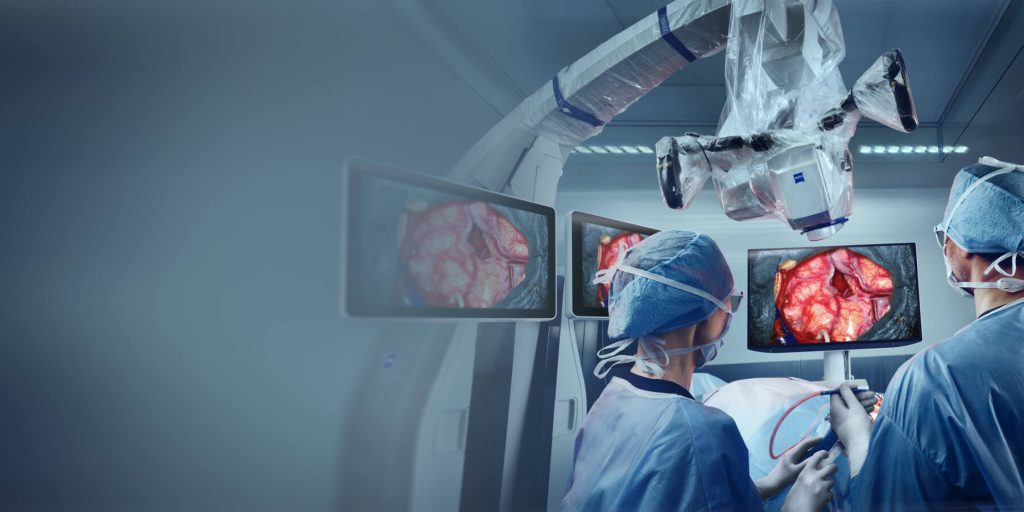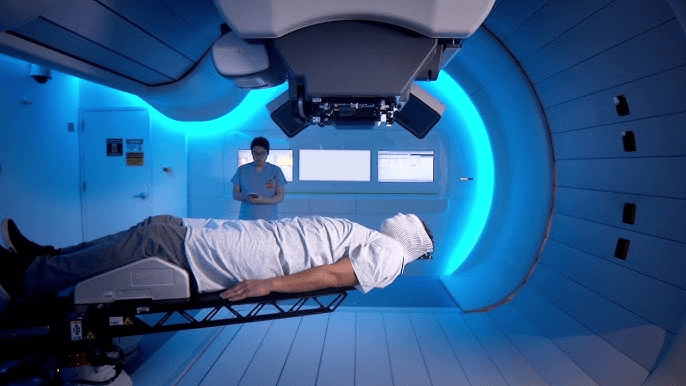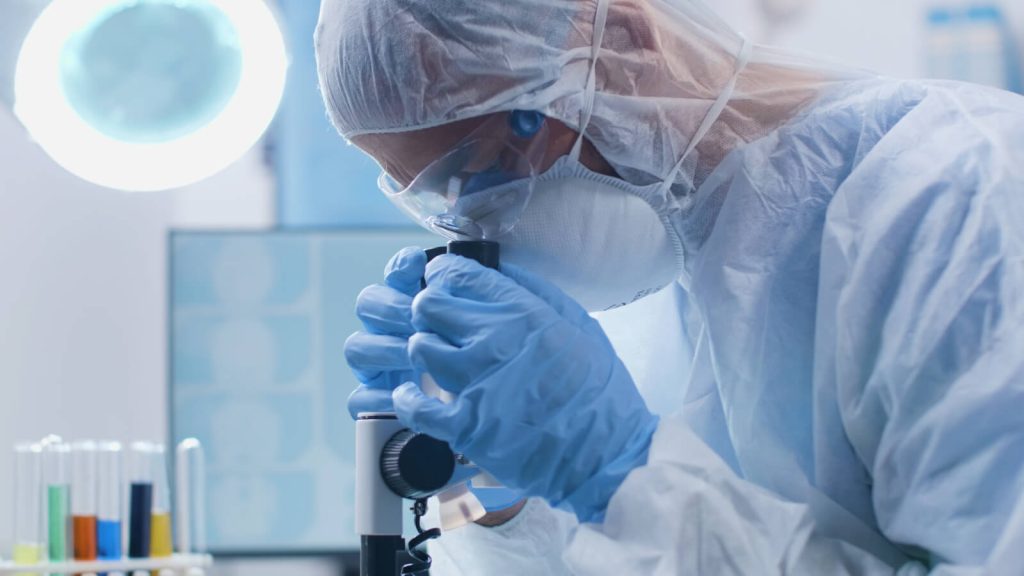Leading experts in neuro-oncology
neurosurgery | systemic oncological treatment | radiation therapy | rehabilitation
Request a free consultationNeuro-oncology institute
Neuro-oncology Institute led by Prof. Gerardo Conesa is a multifunctional medical facility specialized on complex treatment of benign and malignant tumors of the nervous system: brain tumors, spinal tumors and spinal cord tumors.
Experience of our specialists and technical equipment of the hospital allows us
to offer the best treatment for every patient.
Watch the video to know more.


Leading doctors

Prof. Gerardo Conesa
Director of Neuro-Oncology Institute, Leading neurosurgeon
Director of Neuro-Oncology Institute, Leading neurosurgeon Prof. Conesa is the director of the Institute of Neurosurgery and Neuroscience at Teknon Medical Centre. He obtained a medical degree from the University of Barcelona in 1982 and completed his specialization in neurosurgery at the University Hospital de Bellvitge in 1990. He has held internships in the USA and France, and worked in various4 university hospitals in Barcelona since 1985. He is a member of professional organizations such as the European Association of Neurosurgical Societies, the European Union Congress of Neurosurgeons, the Spanish Society of Neurosurgery, and the Walter Dandy Society.
30+ years of clinical experience
Specialization
Brain tumors (glioma, glioblastoma, meningioma, neurinoma, brain metastases)
Lumbar and cervical spine surgery (minimally invasive procedures)
Epilepsy surgery and Deep Brain Stimulation (DBS)

Dr. Carme Balaña
Leading neurooncologist
Dr. Carme Balaña graduated from the Central University of Barcelona and completed her medical oncology residency at Vall d’Hebron Hospital. She holds a doctorate in medicine and previously served as Head of Service at the Institut Català d’Oncologia in Badalona (Can Ruti). Dr. Balaña specializes in neuro-oncology and has held key leadership roles, including President of the Spanish Neuro-Oncology Research Group (GEINO) and membership on the Scientific Committee of the European Association of Neuro-Oncology (EANO). She has also served as an associate professor at the Autonomous University of Barcelona (UAB) and is the author or co-author of over 500 publications, including conference abstracts, peer-reviewed articles, and books. Throughout her career, she has been the principal investigator in more than 80 clinical trials and has been an invited speaker at numerous national and international conferences. Additionally, she has co-authored several editions of the EANO treatment guidelines. Currently, she is a member of the Germans Trias i Pujol Research Institute (IGTP) and has received various research grants in neuro-oncology, including awards from GEINO, the Instituto de la Salud Carlos III, and Marató de TV3.
25+ years of clinical experience
Specialization
Malignant CNS tumors (glioblastoma, astrocytoma, oligodendroglioma,
meningioma, ependymoma, meduloblastoma and others.
Systemic treatment of CNS tumors, including chemotherapy,
targeted therapy, immunotherapy.
Guidance on participation in ongoing clinical trials.
Diagnosis & diagnostic methods
Neuro-oncology is a field of medicine related to treatment of the tumors of the brain, spine and spinal cord tumors. Many of which can be very dangerous and life-threatening (astrocytoma, glioma, glioblastoma, ependymoma, pontine glioma, and brain stem tumors).
Combination of neurosurgical and systemic oncological treatment with radiotherapy is often required for treatment of such tumors.
Due to the great variety of tumor types, different symptoms should be evaluated and a lot of different diagnostic tests may be prescribed.
Most common types of brain tumors
-
Typically Malignant Brain Tumors
Glioblastomas
Anaplastic astrocytomas
Medulloblastoma
Lymphoma
Gliosarcoma
Chordoma
Chondrosarcoma
Metastases of other tumors
-
Typically Benign Brain Tumors
Difuse astrocytoma
Oligodendroglioma
Pilocitic astrocytoma
Ependimoma
Subependimoma
Hemangioblastoma
Pineal tumors: pineocytoma
Meningioma
Pituitary Adenoma
Craniopharyngioma
Schwannoma
Choroid Plexus Tumor
Dysembryoplastic Neuroepithelial Tumor (DNET)
Epidermoid cyst
-
Brain Tumors with Variable Grades (From More Benign to Malignant)
Astrocytomas
Oligodendrogliomas
Subependymoma
Myxopapillary ependymoma
Ependymoma
Hemangiopericytoma
Germ Cell Tumors
Pineal Tumors
Most common types of spine & spinal cord tumors
-
Typically Malignant Brain Tumors
Glioblastomas
Anaplastic astrocytomas
Medulloblastoma
Lymphoma
Gliosarcoma
Chordoma
Chondrosarcoma
Metastases of other tumors
-
Typically Benign Brain Tumors
Difuse astrocytoma
Oligodendroglioma
Pilocitic astrocytoma
Ependimoma
Subependimoma
Hemangioblastoma
Pineal tumors: pineocytoma
Meningioma
Pituitary Adenoma
Craniopharyngioma
Schwannoma
Choroid Plexus Tumor
Dysembryoplastic Neuroepithelial Tumor (DNET)
Epidermoid cyst
-
Brain Tumors with Variable Grades (From More Benign to Malignant)
Astrocytomas
Oligodendrogliomas
Subependymoma
Myxopapillary ependymoma
Ependymoma
Hemangiopericytoma
Germ Cell Tumors
Pineal Tumors
Treatment
Depending on the stage of the disease, the type of tumor and it`s anatomical location, the patient may undergo neurosurgery, systemic oncological therapy and radiation therapy, or a combination of these methods. The treatment plan is determined at a multidisciplinary medical consilium.
Neurosurgical treatment
Depending on the stage of the disease, the type of tumor and it`s anatomical location, the patient may undergo neurosurgery, systemic oncological therapy and radiation therapy, or a combination of these methods.
The treatment plan is determined at a multidisciplinary medical consilium.
-
Complete removal or extirpation of the tumor
In nearly all cases where the tumor can be completely removed surgically, this should be done as soon as possible to avoid disease progression and improve the patient's prognosis.
Certain types of tumors have a high risk of recurrence even after complete removal and may require further radiation therapy and systemic oncological treatment to maintain the results of the surgery.
-
Partial removal or resection of the tumor
When anatomical or functional characteristics of the tumor do not allow to proceed with the complete resection, partial tumor removal may be recommended.
The goal of such an operation is to remove the maximum possible volume of tumor tissue, which allows to reduce the number of tumoral cells for a subsequent treatment, improve the patient's prognosis and reduce the risk of complications.
Special technologies for neurosurgery
Robotic surgical systems, microscopy equipment, and neuronavigation are used to reduce surgical risks.
-
Best Digital Visualization
KINEVO ZEISS 900 Microscope with Quevo endoscopic system
Complex surgeries in the brain and spine require the highest standards in digital and optical visualization. The new ZEISS KINEVO 900 S allows you to visualize small anatomical landmarks or tissue color differences with even more confidence thanks to best digital visualization capabilities and latest 4K 3D camera technology.
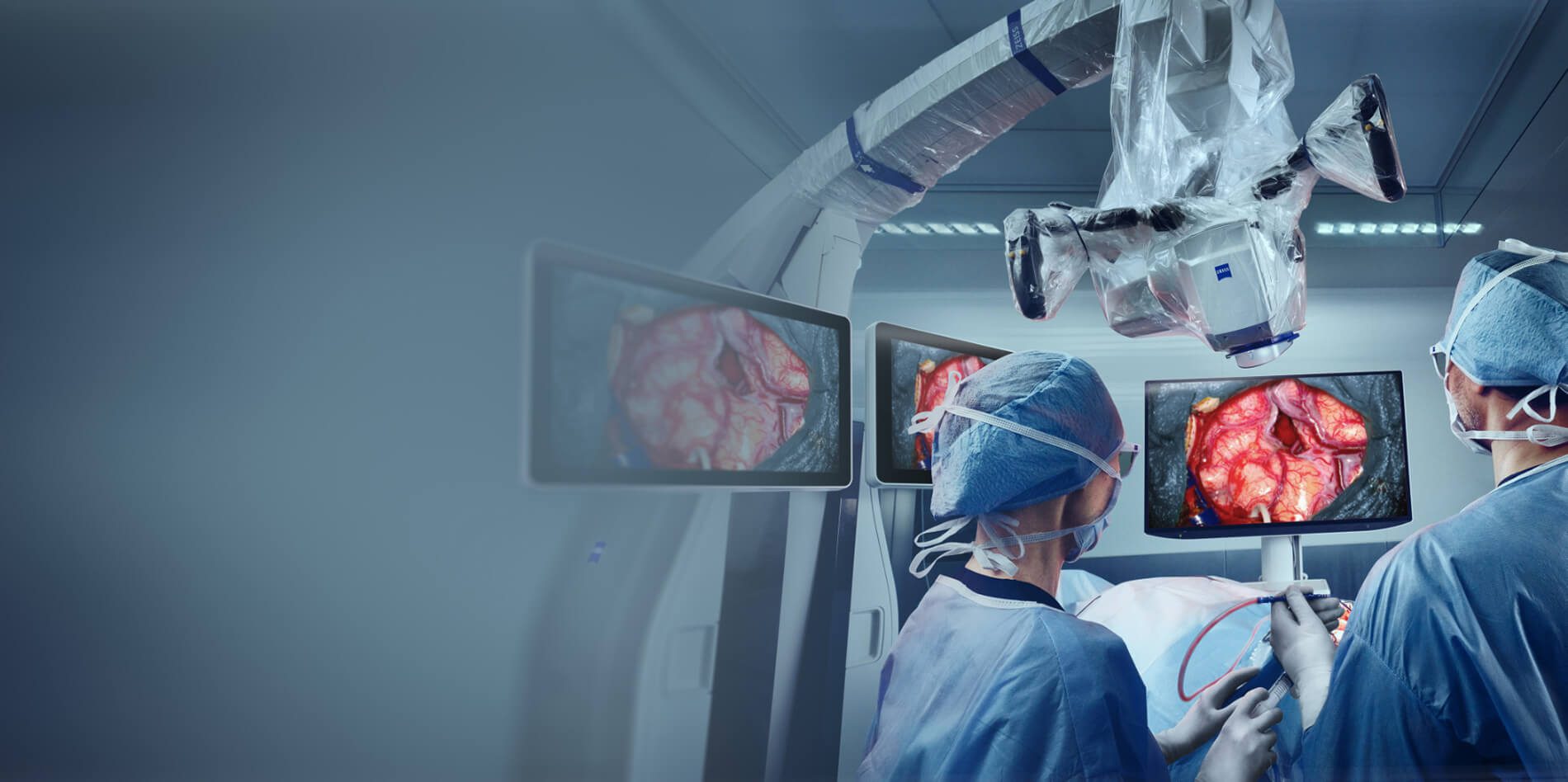
-
Best Digital Visualization
KINEVO ZEISS 900 Microscope with Quevo endoscopic system
Complex surgeries in the brain and spine require the highest standards in digital and optical visualization. The new ZEISS KINEVO 900 S allows you to visualize small anatomical landmarks or tissue color differences with even more confidence thanks to best digital visualization capabilities and latest 4K 3D camera technology.
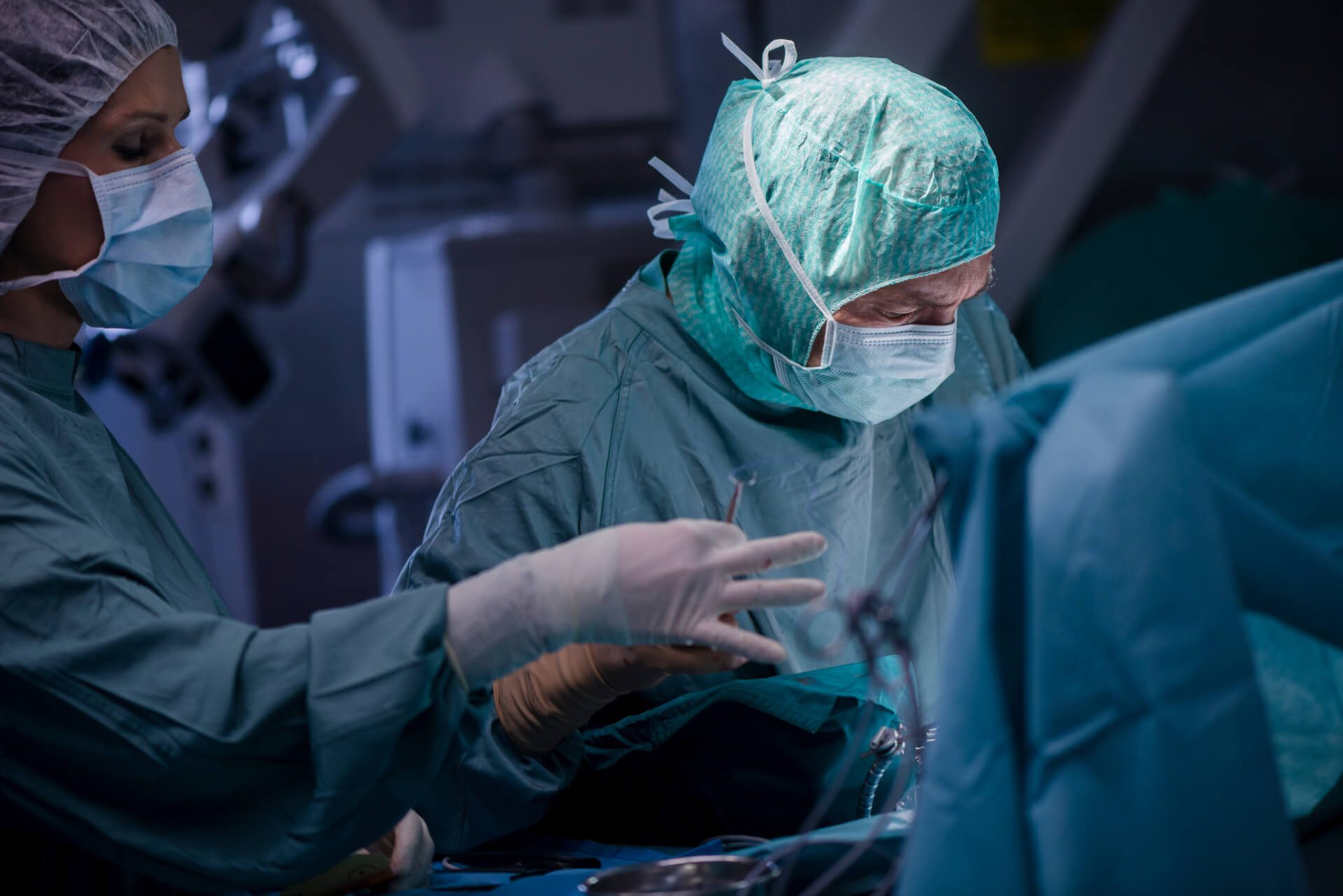
-
Best Digital Visualization
KINEVO ZEISS 900 Microscope with Quevo endoscopic system
Complex surgeries in the brain and spine require the highest standards in digital and optical visualization. The new ZEISS KINEVO 900 S allows you to visualize small anatomical landmarks or tissue color differences with even more confidence thanks to best digital visualization capabilities and latest 4K 3D camera technology.

-
Best Digital Visualization
KINEVO ZEISS 900 Microscope with Quevo endoscopic system
Complex surgeries in the brain and spine require the highest standards in digital and optical visualization. The new ZEISS KINEVO 900 S allows you to visualize small anatomical landmarks or tissue color differences with even more confidence thanks to best digital visualization capabilities and latest 4K 3D camera technology.

-
Best Digital Visualization
KINEVO ZEISS 900 Microscope with Quevo endoscopic system
Complex surgeries in the brain and spine require the highest standards in digital and optical visualization. The new ZEISS KINEVO 900 S allows you to visualize small anatomical landmarks or tissue color differences with even more confidence thanks to best digital visualization capabilities and latest 4K 3D camera technology.

Systemic oncological treatment
Depending on the stage of the disease, the type of tumor and it`s anatomical location, the patient may undergo neurosurgery, systemic oncological therapy and radiation therapy, or a combination of these methods.
The treatment plan is determined at a multidisciplinary medical consilium.
-
Chemotherapy
Chemotherapy refers to a category of medications used to treat malignant tumors by inhibiting tumor growth and reducing tumor burden. These drugs are administered intravenously or taken orally as tablets.
Despite its intimidating reputation, chemotherapy remains one of the most extensively studied cancer treatments. While side effects are common, its toxicity profile is not inherently more severe than modern therapies like immunotherapy or targeted therapy; the impact varies depending on the regimen and patient-specific factors.
-
Immunotherapy
Immunotherapy is a cancer treatment modality designed to bolster the immune system’s ability to combat cancer. Approaches include checkpoint inhibitors, cancer vaccines, oncolytic viral therapy, and CAR T-cell therapy. While its application in brain tumors remains limited, immunotherapy is now standard for certain cancers (e.g., melanoma, lung cancer) and is under active investigation through clinical trials to expand its utility.
-
Targeted therapy
Targeted therapy focuses on blocking specific molecular markers (e.g., proteins, genes) that drive cancer cell proliferation, survival, and metastasis. These therapies are tailored to tumors with identifiable molecular targets, forming the foundation of precision medicine.
A comprehensive molecular profiling of the tumor is essential not only for diagnosis but also to guide treatment selection. For example, targeted therapies are already approved for tumors with BRAF mutations, IDH1/2 mutations, H3 K27M alterations, NTRK fusions, or FGFR abnormalities. Ongoing research is rapidly expanding the list of actionable targets, with significant advancements expected in the coming years.
Radiation therapy
Radiation therapy may be used before, after surgery, or in cases where surgical treatment is not possible due to the anatomical features of the tumor or other characteristics of the medical case.
There are two main methods of radiation therapy: classical radiation therapy on a linear accelerator based on the use of photons and a more modern method of proton therapy, which is based on the use of charged particles - protons.
We have the ability to use both of these methods.
-
Photon-based radiation therapy truebam
The high-precision Truebeam system from Varian, installed at the Teknon Medical Center, uses stereotactic navigation to accurately calculate the trajectory and dosage of radiation, which allows achieving the desired effect with a minimum dose of radiation and preventing the development of complications.
However, in some cases, a more modern method of irradiating the tumor with proton therapy may be recommended.
-
Proton therapy proteus-one from iba
Teknon Medical Center is part of the largest network of clinics in Spain, Quironsalud. This allows us to offer our patients not only classical radiotherapy, but also innovative proton therapy technology, which in some cases can have a significantly more favorable prognosis for the patient.
This treatment is carried out in the specialized Quironsalud Proton Therapy Center in Madrid.
Additional treatment
Tumor Treating Fields (TTFields) are a therapeutic modality that uses low-intensity, alternating electric fields to selectively disrupt the division and proliferation of tumor cells.
-
Tumor Treating Fields (TTFields) — OPTUNE
TTFields target rapidly dividing tumor cells by interfering with mitosis during cell division. This mechanism preferentially affects cancer cells over healthy, non-dividing cells. It’s a device that is put on the head of a patient: the scalp is shaved, and four electrode arrays are placed directly on the skin.
The arrays connect to a portable, battery-powered generator (carried in a backpack), which delivers continuous electric fields to the tumor. Treatment requires near-daily use (≥18 hours/day) for optimal efficacy.

-
Tumor Treating Fields (TTFields) — OPTUNE
TTFields target rapidly dividing tumor cells by interfering with mitosis during cell division. This mechanism preferentially affects cancer cells over healthy, non-dividing cells. It’s a device that is put on the head of a patient: the scalp is shaved, and four electrode arrays are placed directly on the skin.
The arrays connect to a portable, battery-powered generator (carried in a backpack), which delivers continuous electric fields to the tumor. Treatment requires near-daily use (≥18 hours/day) for optimal efficacy.

-
Tumor Treating Fields (TTFields) — OPTUNE
TTFields target rapidly dividing tumor cells by interfering with mitosis during cell division. This mechanism preferentially affects cancer cells over healthy, non-dividing cells. It’s a device that is put on the head of a patient: the scalp is shaved, and four electrode arrays are placed directly on the skin.
The arrays connect to a portable, battery-powered generator (carried in a backpack), which delivers continuous electric fields to the tumor. Treatment requires near-daily use (≥18 hours/day) for optimal efficacy.

Hospital
The Peritoneal Cancer Institute operates at the clinical base of the Teknon Medical Centre, one of the largest multidisciplinary hospitals in Spain, which allows the patient to receive any necessary medical care and provide the necessary care and supervision in the postoperative period. The hospital regularly undergoes international certification and has been certified by Joint Commission International seven times, which guarantees the high quality and safety of medical services.
The hospital employs more than 400 doctors and 2,000 specialists, providing the best medical care for more than 60,000 patients a year.
The versatility of the clinic allows to treat any complications in the postoperative period and comprehensively approach the restoration of the patient's condition, including the preparation of an individual diet and physiotherapy.
“Centro Médico Teknon - el mejor hospital internaciona”
IMTJ: International Medical Travel Journal


For patients
-
Left a free request
Our medical assistant will contact you to find out how we can help you. And prepare your case for consultation with the Doctors.
-
Prepare your medical reports and scans
Send your medical reports, CT & MRI scans to your assistant and he will prepare it for the doctors. So no detail is missed.
-
Get an online consultation with the Doctors
Consult with doctors without leaving home. Video call with the Doctors to discuss your treatment plan and receive an official medical report.
-
Prepare your trip and get the treatment
Once you have made a decision about treatment, our medical assistant will prepare a budget and help organize your visit. The clinic provides visa support.
-
Treatment & hospital stay
Hospitalization in a comfortable individual ward with Barcelona city views. Daily control visits by doctors, a nutritionist, and round-the-clock medical supervision.
-
Follow-up after treatment
We stay in touch with you even after your return home and control the result of treatment. You can always ask your questions to doctors.
For doctors
Peritoneal Cancer Institute collaborates
with doctors and clinics around the world to share knowledge and experience in the fight against peritoneal cancer.
If you are a medical professional interested in cooperation, please fill out the form and we will contact you as soon as possible.



